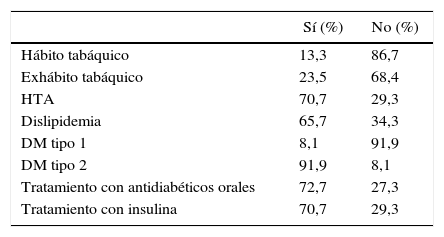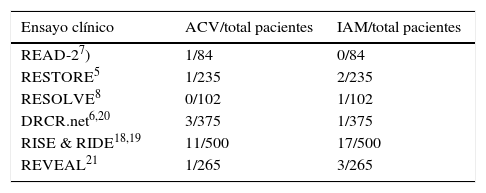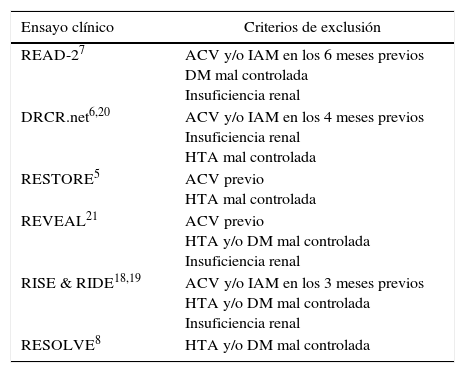Analizar la afectación cardiovascular a corto plazo de los pacientes naïve con edema macular diabético, tratados con ranibizumab intravítreo, tanto pre- como postratamiento.
Material y métodosEstudio retrospectivo y descriptivo de pacientes con edema macular diabético con afectación central, que hubieran iniciado tratamiento con ranibizumab intravítreo en 2014 en el Hospital Universitario Nuestra Señora de Candelaria y el Hospital Universitario y Politécnico La Fe. Se siguieron hasta agosto de 2015, estudiando, entre otras variables, la prevalencia e incidencia de accidente cerebrovascular y de infarto agudo de miocardio.
ResultadosDe las 1.324 inyecciones de ranibizumab intravítreo que se administraron en 2014, solo 159 fueron como inicio de tratamiento, repartidas entre un total de 99 pacientes, ya que más de la mitad de ellos precisó tratamiento de ambos ojos (58,6%). El 58,4% de los pacientes fueron hombres, en la sexta década de la vida (X¯=65,93 años±11,24) y, en su mayoría, no fumadores (86,7%), diabéticos tipo 2 (91,9%), hipertensos (70,7%) y dislipidémicos (65,7%). Se encontraron 6 pacientes (6,1%) con infarto agudo de miocardio y 8 (8,1%) con accidentes cerebrovasculares (ACV) previos al inicio del tratamiento, y solo uno (1%) con accidente cerebrovascular posterior (p=0,039).
ConclusiónEn nuestra experiencia el ranibizumab intravítreo en pacientes con edema macular diabético, con antecedentes de accidente cerebrovascular e infarto agudo de miocardio podría ser una alternativa segura.
To determine the cardiovascular events in naïve patients with diabetic macular oedema, before and after being treated with intravitreal ranibizumab.
Material and methodsA retrospective and descriptive study was conducted on patients with diabetic macular oedema and foveal involvement, who started treatment with intravitreal ranibizumab in 2014 in the Hospital Universitario Nuestra Señora de Candelaria and the Hospital Universitario y Politécnico La Fe. During the follow-up until August 2015, a record was made of parameters, including the prevalence and incidence of stroke and myocardial infarction.
ResultsAmong the 1,324 intravitreal ranibizumab injections administered in 2014, only 159 of them corresponded to treatment initiation in 99 patients, with more than half requiring treatment of both eyes. The study patients included 58.4% males, in the 6th decade of life (Mean=65.93±11.24 years), non-smokers (86.7%), type 2 diabetes (91.9%), hypertension (70.7%), and with dyslipidaemia (65.7%). Prior to treatment initiation, it was found that 6 patients (6.1%) suffered from an acute myocardial infarction, and 8 (8.1%) from stroke, and only one (1%) with post-stroke (P=.039).
ConclusionIn our experience it seems that the intravitreal ranibizumab in diabetic macular oedema could be a safe alternative in patients with a history of stroke and myocardial infarction.
Artículo
Comprando el artículo el PDF del mismo podrá ser descargado
Precio 19,34 €
Comprar ahora










